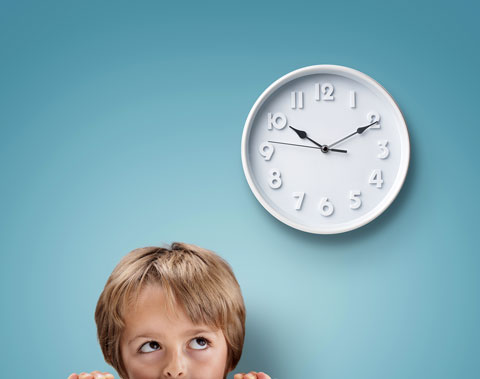Most preschool-age children are not ready to fully grasp such abstract time concepts as duration (the amount of time an event lasts). But preschoolers already deal with duration in a variety of situations, such as when they have to wait for something they want. Here are some ideas for helping older preschoolers use prediction and estimation to learn how time goes by.
Invite older preschoolers to notice how long certain activities last.
- Ask questions such as, “Which do you think takes you a longer time: eating a cracker or drinking a glass of water?” “Do you think it takes us longer to walk to the playground or to walk out to the busses?”
- Point out parts of a clock face and explain some ways that you use a clock. For example, have children compare the position of the hour and minute hands before and after the class goes outside. What do they notice? Explain that the changes represent seconds and minutes passing.
Talk with the class about how people keep track of time.
- Explain that many people use seconds and minutes to measure the amount of time it takes to do something.
- Try teaching the children to count seconds by chanting, “One-one-thousand, two-one-thousand…” or “One-a-penny, two-a-penny…” Let them try chanting in time with a digital timer or stopwatch that shows seconds. Keep in mind that counting to 10 or 20 may be challenging for preschoolers, whether using the chant or not.
- Show children how to use timers, stopwatches, and hourglasses. Try adding these materials to the science or manipulatives center so the children have plenty of time to explore and practice with them.
Adapt physical activities to help children play with time concepts.
- Invite children to do things for a set amount of time. For example, you might ask a child to predict how many times she can jump in 10 seconds. Then assign other children to count her jumps. Say “GO” and then start the timer when the child begins jumping. Her classmates can count the jumps until the timer sounds. Help them compare predictions to the actual number of jumps.
- Pose new questions on other days: “How many seconds can you stand on one foot?” “How many hiders can the seeker find during 2 minutes of Hide and Seek?” “How many seconds can the class bounce a ball on the blanket before it falls off?”
- Ask children to estimate how many minutes it will take to walk to the bus stop or all around the school building. Use a stopwatch to time the walk. Help them compare the actual times to their estimates.
Let children investigate time while cooking.
- When you cook with children, ask them to predict how long certain processes will take. “How many minutes do you think it will take the oven to preheat to 425 degrees?”
- Invite children to experiment: “Will the muffins be puffy and golden after 10 minutes, 15 minutes, 20 minutes?”
IEL Resource
- Resource List: Time and Sequence


 PDF
PDF